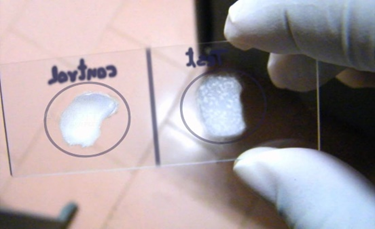COAGULASE TEST
AIM
To differentiate Coagulase positive Staphylococcus
aureus from Coagulase negative Staphylococcus sp. (Staphylococcus
epidermis and Staphylococcus saprophyticus).
PRINCIPLE
Coagulase is an enzyme that works in
conjugation with normal plasma components to convert Fibrinogen to Finbrin and
causes Clotting of Plasma. This enzyme is a good indicator of pathogenic
potential of Staphylococcus aureus. As 97 % of the strains of Staphylococcus
aureus have proven to be Coagulase positive, the Coagulase test is useful
for differentiating Staphylococcus aureus from other Gram positive,
Catalase negative cocci.
Staphylococcus aureus
produces two types of Coagulases. First one is Bound Coagulase and the Second
one is Free Coagulase. Slide coagulase test is done to detect Bound coagulase,
whereas Tube coagulase test is done to detect Free coagulase. Both Slide and
Tube coagulase tests utilize Rabbit plasma treated with anticoagulant to
interrupt the normal clotting mechanism.
Bound Coagulase
- Bound Coagulase is also known as Clumping factor.
- Bound Coagulase is attached to bacterial cell wall and reacts directly with Fibrinogen. This is shown by formation of visible mass. It doesn’t require Coagulase Reacting Factor (CRF).
Free Coagulase
- Free Coagulase is an extracellular enzyme (released from the cell).
- Free Coagulase converts Fibrinogen to Fibrin by activity of Coagulase Reacting Factor (CRF) in plasma. This is detected by appearance of fibrin clot in the Tube coagulase test. It is usually recommended to do tube Coagulase test on all ‘Slide-coagulase-negative’ Staphylococci.
MATERIALS REQUIRED
- Test bacteria
- Saline
- Plasma
- Glass slide
- Test tubes
- Inoculation loop
- Incubator
PROCEDURE
Slide Coagulase Test
a) Place two separate drops of saline on a slide.
b) Using a sterile inoculating loop, emulsify one or two
colonies of organism in one drop to make thick suspension of bacteria.
c) Add a loopful of plasma to both the suspension and
saline drop and mix gently.
d) Look for immediate coarse clumping of the mixture
within 10-15 seconds.
Tube Coagulase Test
a) Dilute the plasma as 1:10 Dilution with saline.
b) Take 2 test tubes and add 0.5 ml of diluted plasma to
each.
c) Inoculate a tube with bacterial colonies to make a
cloudy suspension. Alternatively, add about 5 drops of thick 18 - 24 hours
broth cultures.
d) Incubate both tubes at 35 °C for 1 to 4 hours in water
bath.
e) Afterward, examine both tubes for presence or absence
of clots.
OBSERVATION AND RESULTS
- In Slide Coagulase Test, positive reaction was observed by formation of Macroscopic clumping in 10 seconds or less in coagulated plasma drop and no clumping in saline or water drop after addition of loopful of bacterial culture. In negative reaction, no clumping in either drops.
- In Tube Coagulase Test, positive reaction was observed by Clot of plasma drop at any size after addition of loopful of bacterial culture but in negative reaction no Clot was observed.


Comments
Post a Comment